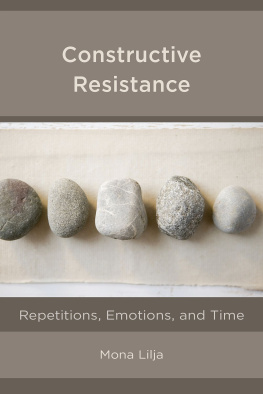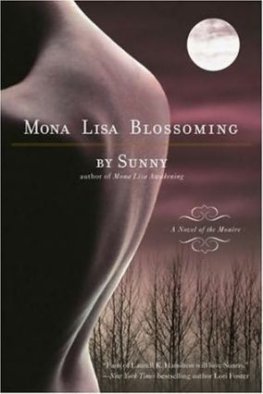Mona Lilja - Constructive Resistance: Repetitions, Emotions and Time
Here you can read online Mona Lilja - Constructive Resistance: Repetitions, Emotions and Time full text of the book (entire story) in english for free. Download pdf and epub, get meaning, cover and reviews about this ebook. year: 2021, publisher: Rowman & Littlefield, genre: Politics. Description of the work, (preface) as well as reviews are available. Best literature library LitArk.com created for fans of good reading and offers a wide selection of genres:
Romance novel
Science fiction
Adventure
Detective
Science
History
Home and family
Prose
Art
Politics
Computer
Non-fiction
Religion
Business
Children
Humor
Choose a favorite category and find really read worthwhile books. Enjoy immersion in the world of imagination, feel the emotions of the characters or learn something new for yourself, make an fascinating discovery.
- Book:Constructive Resistance: Repetitions, Emotions and Time
- Author:
- Publisher:Rowman & Littlefield
- Genre:
- Year:2021
- Rating:4 / 5
- Favourites:Add to favourites
- Your mark:
- 80
- 1
- 2
- 3
- 4
- 5
Constructive Resistance: Repetitions, Emotions and Time: summary, description and annotation
We offer to read an annotation, description, summary or preface (depends on what the author of the book "Constructive Resistance: Repetitions, Emotions and Time" wrote himself). If you haven't found the necessary information about the book — write in the comments, we will try to find it.
Mona Lilja: author's other books
Who wrote Constructive Resistance: Repetitions, Emotions and Time? Find out the surname, the name of the author of the book and a list of all author's works by series.
Constructive Resistance: Repetitions, Emotions and Time — read online for free the complete book (whole text) full work
Below is the text of the book, divided by pages. System saving the place of the last page read, allows you to conveniently read the book "Constructive Resistance: Repetitions, Emotions and Time" online for free, without having to search again every time where you left off. Put a bookmark, and you can go to the page where you finished reading at any time.
Font size:
Interval:
Bookmark:

Constructive Resistance
To my husband, Mikael Baaz
Constructive Resistance
Repetitions, Emotions, and Time
Mona Lilja
ROWMAN & LITTLEFIELD
Lanham Boulder New York London
Published by Rowman & Littlefield
An imprint of The Rowman & Littlefield Publishing Group, Inc.
4501 Forbes Boulevard, Suite 200, Lanham, Maryland 20706
www.rowman.com
6 Tinworth Street, London SE11 5AL, United Kingdom
Copyright 2021 by Mona Lilja
All photographs Ola Kjelbye
All rights reserved . No part of this book may be reproduced in any form or by any electronic or mechanical means, including information storage and retrieval systems, without written permission from the publisher, except by a reviewer who may quote passages in a review.
British Library Cataloguing in Publication Information Available
Library of Congress Control Number: 2020948897
ISBN 9781538146484 (cloth : alk. paper) | ISBN 9781538146491 (epub)
 The paper used in this publication meets the minimum requirements of American National Standard for Information SciencesPermanence of Paper for Printed Library Materials, ANSI/NISO Z39.48-1992.
The paper used in this publication meets the minimum requirements of American National Standard for Information SciencesPermanence of Paper for Printed Library Materials, ANSI/NISO Z39.48-1992.
Contents
We are familiar with representations of resistance: massive events that confront oppressive forces head on. These dramatic acts of dissent range from public rallies and street marches to labor strikes and civil disobedience campaigns. Sometimes they are brutally repressed, sometimes they go unnoticed, sometimes they lead to revolutionary change.
Mona Liljas impressive book on Constructive Resistance is part of a scholarly movement that urges us to think of resistance in broader and more productive ways. It is part of a body of literature on everyday forms of resistance that ranges from early influential conceptual contributions (such as Scott 1990) to more recent empirical studies (such as Sombatpoonsiri 2015). Lilja writes in the wake of such inquiries and stresses, with them, that the most powerful forms of oppression are not necessarily institutional structures but societal norms that determine what is acceptable, moral, and rational, and what not.
I am deeply honored by the opportunity to offer a few opening remarks to Constructive Resistance . They are designed to contextualize and introduce the key themes of Liljas timely and compelling book. There is no space here to engage in detail either her arguments or the meanwhile extensive and complex bodies of literature on the issues at stakeexcept to note that we do, indeed, live in an age of resistance. For several years now resistance movements have emerged in all parts of the world, from the Arab Spring to Occupy Wall Street and widespread street protests in Hong Kong (Wight 2019). They are symptomatic of a larger malaise that emerges when existing institutional structures and decision-making processes are unable to deal with and solve major political tensions and problems (see Carter 1970; Solnit 2019).
Constructive Resistance urges us to look not only at dissent that opposes existing forms of domination and exclusion, but also, and primarily, at resistance practices that open up thinking space and allow us to imagine a different future. Doing so entails making a number of theoretical and empirical shifts, away from focusing on direct challenges to the existing order and away from understanding power as purely oppressive. Instead, the key is to see and appreciate the productive sides of power and resistance: the potential that lies in generating sociopolitical change.
Lilja calls such practices constructive resistance because they are primarily about exploring how we can imagine the world differently and how these alternative visions can eventually become acceptable and form the bases of new sociopolitical relations. These counter-visions and counter-discourses have a lot of parallels with what decolonial scholarship seeks to do: to go beyond exposing the legacies of colonialism and, instead, focus on validating different ways of being and knowing, as, for instance, those that are entailed in largely neglected Indigenous epistemologies and political orders (see, for instance, Capan 2017; Mignolo 2009; Graham et al. 2011).
Understanding how constructive resistance can yield power and generate change is rather daunting and requires addressing several conceptual and empirical challenges. Two stand out.
First: everyday forms of dissent are, as Lilja acknowledges, inevitably entangled with the complexities of life. They may produce as much acquiescence as they entail resistance. Compromises have to be made. Does a young graffiti artist in the West Bank engage in resistance when spaying a subversive slogan on a public wall under the cover of darkness (see Ball 2020; Weitzel 2019)? Or is this covert act ultimately legitimizing the occupation and strengthening what Herbert Marcuse (1965) called repressive tolerance: providing an illusion of dissent and, in doing so, further legitimizes forms of domination?
Second: constructive resistance can only work over time, by changing how weas collectivesthink and imagine the word differently. This slow transformation of values cannot be understood through conventional notions of human agency and the types of causal models that prevail in much of the social sciences. A constructive everyday act of resistancewhether it is a graffiti sprayed anonymously on a wall or a refusal to use racist languagedoes not cause a particular political event. Its effects cannot be measured in terms of direct and immediate outcomes. Most people will not even notice. But taken together, countless acts of constructive resistance, enacted over a long period of time, can spread through society and open up the potential for new ideas and values to become acceptable. In doing so, constructive resistance provides the preconditions for meaningful social and political change. This is how opposition to slavery eventually turned into the abolition movement and generated new societal norms and new political practices (see Hutchison 2020). This is how the womens movement emerged and moved from the margins of society to a powerful force of social transformation (Lerner 1993). And this is how countless political struggles are waged today, from same-sex marriage campaigns to attempts at addressing racism and structural violence.
Lilja engages these two challenges in a fascinating manner. To illuminate the power of constructive resistance she explores the role of representations and how they enact an interactive relationship between time, emotion, and repetition. Representations are important because they are one of the most important ways through which individual experiences become collectively meaningful and acquire political significance (see Hutchison and Bleiker 2014). Such representations go way beyond the obvious, such as media depictions of protest movements. They come in visual, verbal, and performative forms and include, as Lilja outlies, museum exhibitions, photographs, stories, or reproduction of cultural artifacts. Representations shape how we view the world: they delineate what we can see and feel and conceptualize from what lies beyond our vision and comprehension. The political nature and consequences of this division of the visible and invisible are meanwhile well recognized and widely discussed (see Rancire 2004).
Lilja enters these discussions by showing how repetition is at the core of how we see, feel, and represent the world. They are crucial to how power and productive resistance work. Repetitions entrench alter and transform values. They are part of how our collective values are communicated, handed down from generation to generation. The relationship between domination, resistance, and change is an inevitable and daily part of these sociopolitical constellations. It is in this constant interaction between sameness and difference that the potential for imagining new worlds lies. The world never stays still. Even if we keep repeating the same representations these very representations take on different meanings and political significance as time moves on. Take a fourteenth-century painting of the Madonna and child. When displayed in a museum today this painting is seen and perceived in completely different ways than when it was originally painted over half a millennia ago in Europe. Things get even more complex when we look at different visual representation of this paining, such as imprints on posters, book covers, or T-shirts, for instance. These forms of repetition entail, as Lilja puts it, both sameness and difference. They refer to the same artifact, but each repetition adds a different layer of representations and so do the societal interpretations of these representations, which both reflect and enact changing values, from religious norms to gender assumption. This is why Lilja stresses that to get the same message across a form of representation cannot just repeat its message. One has to slightly alter the message in order to account for how previous representations have been viewed and absorbed collectively. Look, for instance, at the much-discussed phenomenon of compassion fatigue. Susan Moeller (1999) looks at images of suffering victims that lie at the core of media coverage of humanitarian crises. She argues that viewers who regularly see these suffering victims, again and again, get to the point of feeling numb and indifferent. As a result, the very same image of a suffering victim has a different effect when it is seen the first time (evoking pain and empathy and compassion) than when it is seen the hundredth time (evoking emotional overload, fatigue, and indifference).
Font size:
Interval:
Bookmark:
Similar books «Constructive Resistance: Repetitions, Emotions and Time»
Look at similar books to Constructive Resistance: Repetitions, Emotions and Time. We have selected literature similar in name and meaning in the hope of providing readers with more options to find new, interesting, not yet read works.
Discussion, reviews of the book Constructive Resistance: Repetitions, Emotions and Time and just readers' own opinions. Leave your comments, write what you think about the work, its meaning or the main characters. Specify what exactly you liked and what you didn't like, and why you think so.










